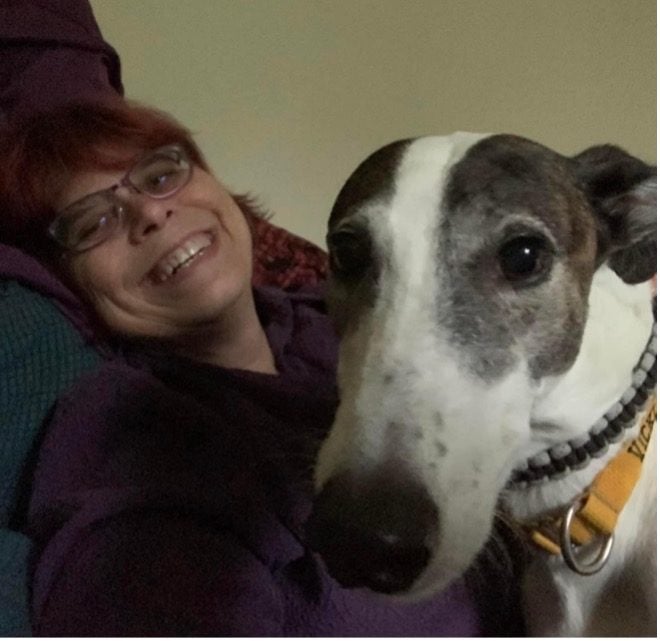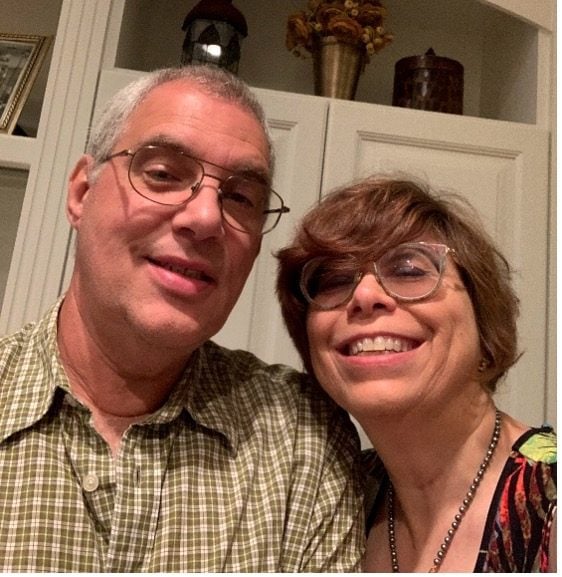
Throughout my life, I have always enjoyed keeping myself busy, whether that was through school, work, hobbies or surrounding myself with family and friends. When my cancer diagnosis prevented me from working and doing the activities I loved when I was just 54, I knew I needed a solution.
In the summer of 2014, I found myself starting to feel tired all the time. At first, I didn’t think anything of it—I was working on my master’s degree, so it was taking a lot out of me. But one morning I found several lumps on the back of my neck, and I knew something wasn’t right. I saw my primary care physician, and while he said we could “wait and see,” I wanted to see a specialist immediately.
Around that time, I also had an abnormal mammogram, so I was referred to an oncologist. The clinicians conducted some blood tests that revealed a highly elevated white blood cell count. In September of 2014, my oncologist diagnosed me with chronic lymphocytic leukemia (CLL), which I learned is the most common type of leukemia in adults.

The word “cancer” shocked me, and my thoughts went to the worst-case scenario. Suddenly, I saw each decision in my life through a different lens. I asked my doctor: “Should I get the short-term or the long-term phone plan?” I didn’t know what else to say. I was fortunate that my oncologist was very supportive, assuring me that it was treatable, slow-growing and that we would take treatment one step at a time. That’s exactly what we did.
Within a few weeks, I had a port placed to begin a six-month chemotherapy regimen. I had a difficult time with the chemo and was experiencing quite a few side effects. However, the treatment ended up being a success. By April 2015 I was in remission.
Unfortunately, it didn’t last. In 2019, my CLL started to affect my day-to-day life and the activities I enjoyed doing. My oncologist recommended I try an oral targeted therapy. I agreed.
But unfortunately, I experienced side effects that were unpleasant for me, such as upper respiratory distress, nausea, diarrhea and swelling. I was on the therapy for almost two years before my doctor recommended stopping treatment in April of 2021, due to these persistent side effects. My CLL did not progress for a little over a year before a bone marrow biopsy indicated an increase in my blood counts for a third time.
This was when my oncologist recommended CALQUENCE (acalabrutinib), another oral targeted therapy, as the next line of treatment. Since starting CALQUENCE, I have experienced some gastrointestinal issues—but overall, it has been manageable.
While I recognize the experience may not be this way for every patient, I have started to feel more energetic and like myself again. CALQUENCE has given me a chance to give back to the community and repay all that they have done for me when I was sick. One of the best parts has been the way this treatment fits into my schedule, which has allowed me to get most of my life back and return to doing the things I love such as volunteer work, attending my music group and painting.

After being diagnosed, I made my story public to share my experience and hopefully help others who may be going through anything similar. I’ve been fortunate to have an amazing support network. Through it all, my husband Rich has been my rock and I have greatly appreciated his strength, along with members from my church, friends from my music groups and my family. I’ve felt so supported. I don’t know what I would have done without them.
My journey is not always smooth sailing, but I am glad that I have open communication with my doctor to discuss my options.
I recommend anyone diagnosed with blood cancer or other types of cancer be open with your doctor and discuss both the physical and non-physical side effects that you are experiencing. I encourage you to stay positive, trust the process and advocate for yourself: talk with your loved ones and your healthcare provider about what’s important to you while discussing which treatment option(s) might be appropriate.
Important Safety Information About CALQUENCE® (acalabrutinib)
Before taking CALQUENCE, tell your healthcare provider about all of your medical conditions, including if you:
- have had recent surgery or plan to have surgery. Your healthcare provider may stop CALQUENCE for any planned medical, surgical, or dental procedure.
- have bleeding problems.
- have or had heart rhythm problems.
- have an infection.
- have or had liver problems, including hepatitis B virus (HBV) infection.
- are pregnant or plan to become pregnant. CALQUENCE may harm your unborn baby and cause problems during childbirth (dystocia).
-
- If you are able to become pregnant, your healthcare provider may do a pregnancy test before you start treatment with CALQUENCE
- Females who are able to become pregnant should use effective birth control (contraception) during treatment with CALQUENCE and for at least 1 week after the last dose of CALQUENCE
- are breastfeeding or plan to breastfeed. It is not known if CALQUENCE passes into your breast milk. Do not breastfeed during treatment with CALQUENCE and for at least 2 weeks after your final dose of CALQUENCE.
Tell your healthcare provider about all the medicines you take, including prescription and over-the-counter medicines, vitamins, and herbal supplements. Taking CALQUENCE with certain other medications may affect how CALQUENCE works and can cause side effects. Especially tell your healthcare provider if you take a blood thinner medicine.
How should I take CALQUENCE?
- Take CALQUENCE exactly as your healthcare provider tells you to take it.
- Do not change your dose or stop taking CALQUENCE unless your healthcare provider tells you to.
- Your healthcare provider may tell you to decrease your dose, temporarily stop, or completely stop taking CALQUENCE if you develop certain side effects.
- Do not switch (interchange) your CALQUENCE tablets with CALQUENCE capsules.
- Take CALQUENCE 2 times a day (about 12 hours apart).
- Take CALQUENCE with or without food.
- Swallow CALQUENCE capsules or tablets whole with a glass of water. Do not open, break, or chew capsules; do not chew, crush, dissolve, or cut tablets.
- If taking CALQUENCE capsules: If you need to take an antacid medicine (such as Tums or Rolaids), take it either 2 hours before or 2 hours after you take CALQUENCE capsules. If you need to take certain other medicines called acid reducers (H2-receptor blockers, such as Pepcid), take CALQUENCE capsules 2 hours before the acid reducer medicine. Avoid taking proton pump inhibitors (such as Prevacid, Prilosec or Nexium).
- If taking CALQUENCE tablets: CALQUENCE tablets can be taken with any stomach acid-reducing medicines, including proton pump inhibitors, H2-receptor blockers, or antacids.
- If you miss a dose of CALQUENCE, take it as soon as you remember. If it is more than 3 hours past your usual dosing time, skip the missed dose and take your next dose of CALQUENCE at your regularly scheduled time. Do not take an extra dose to make up for a missed dose.
What are the possible side effects of CALQUENCE?
CALQUENCE may cause serious side effects, including:
- Serious infections can happen during treatment with CALQUENCE and may lead to death. Your healthcare provider may prescribe certain medicines if you have an increased risk of getting infections. Tell your healthcare provider right away if you have any signs or symptoms of an infection, including fever, chills, or flu-like symptoms.
- Bleeding problems (hemorrhage) can happen during treatment with CALQUENCE and can be serious and may lead to death. Your risk of bleeding may increase if you are also taking a blood thinner medicine. Tell your healthcare provider if you have any signs or symptoms of bleeding, including blood in your stools or black stools (looks like tar), pink or brown urine, unexpected bleeding or bleeding that is severe or you cannot control, vomit blood or vomit that looks like coffee grounds, cough up blood or blood clots, dizziness, weakness, confusion, changes in your speech, headache that lasts a long time, or bruising or red or purple skin marks.
- Decrease in blood cell counts. Decreased blood counts (white blood cells, platelets, and red blood cells) are common with CALQUENCE, but can also be severe. Your healthcare provider should do blood tests to check your blood counts regularly during treatment with CALQUENCE.
- Second primary cancers. New cancers have happened in people during treatment with CALQUENCE, including cancers of the skin or other organs. Your healthcare provider will check you for skin cancers during treatment with CALQUENCE. Use sun protection when you are outside in sunlight.
- Heart rhythm problems (atrial fibrillation and atrial flutter) have happened in people treated with CALQUENCE. Tell your healthcare provider if you have any of the following signs or symptoms: fast or irregular heartbeat, dizziness, feeling faint, chest discomfort, or shortness of breath.
The most common side effects of CALQUENCE include headache, diarrhea, muscle and joint pain, upper respiratory tract infection, and bruising.
These are not all the possible side effects of CALQUENCE. Call your doctor for medical advice about side effects. You may report side effects to FDA at 1-800-FDA-1088.
What is CALQUENCE
CALQUENCE is a prescription medicine used to treat adults with chronic lymphocytic leukemia (CLL) or small lymphocytic lymphoma (SLL).
It is not known if CALQUENCE is safe and effective in children.
Please see full Prescribing Information, including Patient Information.
You may report side effects related to AstraZeneca products.
For more information about CLL and CALQUENCE, visit https://www.calquence.com/cll.html.
CALQUENCE is a registered trademark of the AstraZeneca group of companies.
©2023 AstraZeneca. All rights reserved. US-77712 Last Updated 12/23
